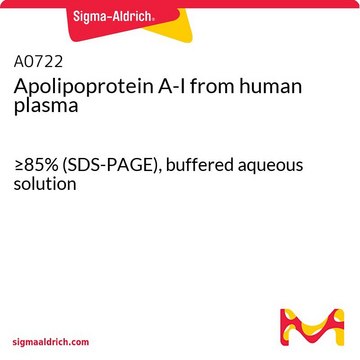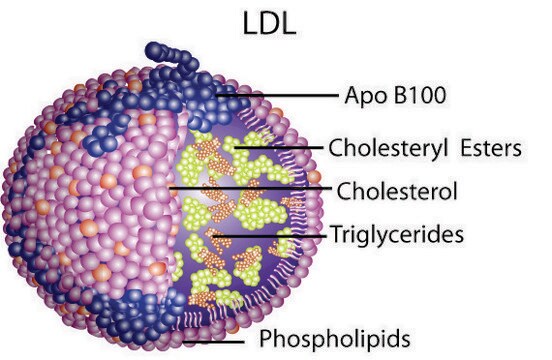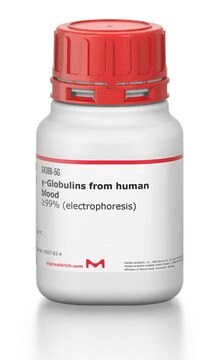ALP60
Apolipoprotein C-III, human
Synonyme(s) :
ApoCIII
Se connecterpour consulter vos tarifs contractuels et ceux de votre entreprise/organisme
About This Item
Code UNSPSC :
12352202
eCl@ss :
32160405
Nomenclature NACRES :
NA.41
Produits recommandés
Source biologique
human
Niveau de qualité
100
300
Pureté
>95% (SDS-PAGE)
Forme
liquid
Fabricant/nom de marque
Chemicon®
Numéro d'accès NCBI
Numéro d'accès UniProt
Description générale
Apolipoprotein C-III (APOC3) is a multifaceted protein, localized on circulating triglyceride-rich lipoproteins (TRLs), high-density lipoprotein (HDL), low-density lipoprotein (LDL), and very-low-density lipoprotein (VLDL). The APOC3 gene is mapped to the human chromosome 11q23.3. It is mainly expressed in hepatocytes and to a lesser extent in enterocytes.
Product Source: Human plasma tested negative for HBsAg and HIV-I, HIV-II, HBc and Hepatitis C antibodies. All blood products should be treated as potentially infectious.
Application
Apolipoprotein C-III (APOC3), human has been used to determine its effect reconstituted high-density lipoprotein (rHDL) containing apoA-I. It has also been used to test the effects of the exogenous exchangeable apolipoproteins on low-density lipoprotein (LDL) binding to heparin.
Actions biochimiques/physiologiques
Apolipoprotein C-III (APOC3) is involved in triglyceride metabolism and atherosclerotic lesion formation. It also regulates pathological processes involved in atherosclerosis. APOC3 stimulates hypertriglyceridemia (HTG) through various mechanisms. It functions as a lipoprotein lipase (LPL) inhibitor and also interrupts the clearance of triglyceride-rich lipoproteins (TRLs)-remnants. Mutations in the gene lead to lower plasma glycerides and lower cardiovascular disease risk.
The physiological role of Apo CIII is unknown. It is suggested that Apo CIII may inhibit the activation of lipoprotein lipase by Apo CII.
Forme physique
Liquid in 10 mM NH4HCO3, pH 7.4.
Stockage et stabilité
Maintain at -20ºC or below in undiluted aliquots for up to 12 months. Avoid repeated freeze/thaw cycles. All blood products should be treated as potentially infectious.
Informations légales
CHEMICON is a registered trademark of Merck KGaA, Darmstadt, Germany
Clause de non-responsabilité
Unless otherwise stated in our catalog or other company documentation accompanying the product(s), our products are intended for research use only and are not to be used for any other purpose, which includes but is not limited to, unauthorized commercial uses, in vitro diagnostic uses, ex vivo or in vivo therapeutic uses or any type of consumption or application to humans or animals.
Code de la classe de stockage
12 - Non Combustible Liquids
Classe de danger pour l'eau (WGK)
nwg
Point d'éclair (°F)
Not applicable
Point d'éclair (°C)
Not applicable
Certificats d'analyse (COA)
Recherchez un Certificats d'analyse (COA) en saisissant le numéro de lot du produit. Les numéros de lot figurent sur l'étiquette du produit après les mots "Lot" ou "Batch".
Déjà en possession de ce produit ?
Retrouvez la documentation relative aux produits que vous avez récemment achetés dans la Bibliothèque de documents.
Rayabarapu Pranavchand et al.
Lipids in health and disease, 16(1), 116-116 (2017-06-15)
Given the characteristic atherogenic dyslipidemia of south Indian population and crucial role of APOA1, APOC3, APOA4 and APOA5 genes clustered in 11q23.3 chromosomal region in regulating lipoprotein metabolism and cholesterol homeostasis, a large number of recently identified variants are to
Kyung-Hyun Cho
Molecules and cells, 27(3), 291-297 (2009-03-28)
Apolipoprotein (apo) C-III is a marker protein of triacylglycerol (TG)-rich lipoproteins and high-density lipoproteins (HDL), and has been proposed as a risk factor of coronary heart disease. To compare the physiologic role of reconstituted HDL (rHDL) with or without apoC-III
Notre équipe de scientifiques dispose d'une expérience dans tous les secteurs de la recherche, notamment en sciences de la vie, science des matériaux, synthèse chimique, chromatographie, analyse et dans de nombreux autres domaines..
Contacter notre Service technique







